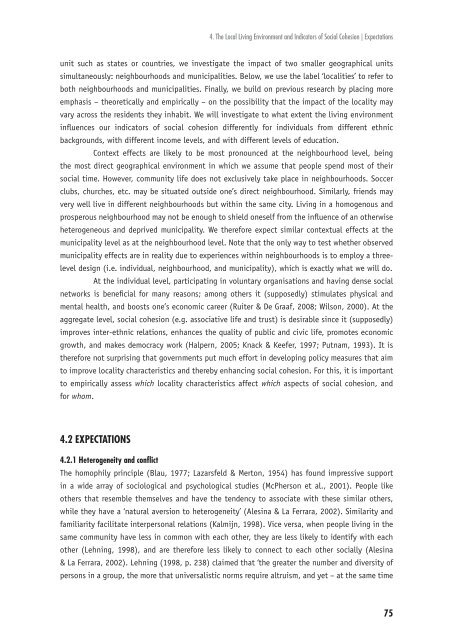Ethnic Hostility among Ethnic Majority and Minority Groups
Ethnic Hostility among Ethnic Majority and Minority Groups
Ethnic Hostility among Ethnic Majority and Minority Groups
You also want an ePaper? Increase the reach of your titles
YUMPU automatically turns print PDFs into web optimized ePapers that Google loves.
unit such as states or countries, we investigate the impact of two smaller geographical units<br />
simultaneously: neighbourhoods <strong>and</strong> municipalities. Below, we use the label ‘localities’ to refer to<br />
both neighbourhoods <strong>and</strong> municipalities. Finally, we build on previous research by placing more<br />
emphasis – theoretically <strong>and</strong> empirically – on the possibility that the impact of the locality may<br />
vary across the residents they inhabit. We will investigate to what extent the living environment<br />
infl uences our indicators of social cohesion differently for individuals from different ethnic<br />
backgrounds, with different income levels, <strong>and</strong> with different levels of education.<br />
Context effects are likely to be most pronounced at the neighbourhood level, being<br />
the most direct geographical environment in which we assume that people spend most of their<br />
social time. However, community life does not exclusively take place in neighbourhoods. Soccer<br />
clubs, churches, etc. may be situated outside one’s direct neighbourhood. Similarly, friends may<br />
very well live in different neighbourhoods but within the same city. Living in a homogenous <strong>and</strong><br />
prosperous neighbourhood may not be enough to shield oneself from the infl uence of an otherwise<br />
heterogeneous <strong>and</strong> deprived municipality. We therefore expect similar contextual effects at the<br />
municipality level as at the neighbourhood level. Note that the only way to test whether observed<br />
municipality effects are in reality due to experiences within neighbourhoods is to employ a threelevel<br />
design (i.e. individual, neighbourhood, <strong>and</strong> municipality), which is exactly what we will do.<br />
At the individual level, participating in voluntary organisations <strong>and</strong> having dense social<br />
networks is benefi cial for many reasons; <strong>among</strong> others it (supposedly) stimulates physical <strong>and</strong><br />
mental health, <strong>and</strong> boosts one’s economic career (Ruiter & De Graaf, 2008; Wilson, 2000). At the<br />
aggregate level, social cohesion (e.g. associative life <strong>and</strong> trust) is desirable since it (supposedly)<br />
improves inter-ethnic relations, enhances the quality of public <strong>and</strong> civic life, promotes economic<br />
growth, <strong>and</strong> makes democracy work (Halpern, 2005; Knack & Keefer, 1997; Putnam, 1993). It is<br />
therefore not surprising that governments put much effort in developing policy measures that aim<br />
to improve locality characteristics <strong>and</strong> thereby enhancing social cohesion. For this, it is important<br />
to empirically assess which locality characteristics affect which aspects of social cohesion, <strong>and</strong><br />
for whom.<br />
4.2 EXPECTATIONS<br />
4. The Local Living Environment <strong>and</strong> Indicators of Social Cohesion | Expectations<br />
4.2.1 Heterogeneity <strong>and</strong> confl ict<br />
The homophily principle (Blau, 1977; Lazarsfeld & Merton, 1954) has found impressive support<br />
in a wide array of sociological <strong>and</strong> psychological studies (McPherson et al., 2001). People like<br />
others that resemble themselves <strong>and</strong> have the tendency to associate with these similar others,<br />
while they have a ‘natural aversion to heterogeneity’ (Alesina & La Ferrara, 2002). Similarity <strong>and</strong><br />
familiarity facilitate interpersonal relations (Kalmijn, 1998). Vice versa, when people living in the<br />
same community have less in common with each other, they are less likely to identify with each<br />
other (Lehning, 1998), <strong>and</strong> are therefore less likely to connect to each other socially (Alesina<br />
& La Ferrara, 2002). Lehning (1998, p. 238) claimed that ‘the greater the number <strong>and</strong> diversity of<br />
persons in a group, the more that universalistic norms require altruism, <strong>and</strong> yet – at the same time<br />
75












